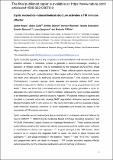Cyclic nucleotide-induced helical structure activates a TIR immune effector
Date
25/08/2022Author
Grant ID
01018608
BB/S000313/1
BB/T004789/1
Keywords
Metadata
Show full item recordAbstract
Cyclic nucleotide signalling is a key component of antiviral defence in all domains of life. Viral detection activates a nucleotide cyclase to generate a second messenger, resulting in activation of effector proteins. This is exemplified by the metazoan cGAS–STING innate immunity pathway1, which originated in bacteria2. These defence systems require a sensor domain to bind the cyclic nucleotide and are often coupled with an effector domain that, when activated, causes cell death by destroying essential biomolecules3. One example is the Toll/interleukin-1 receptor (TIR) domain, which degrades the essential cofactor NAD+ when activated in response to infection in plants and bacteria2,4,5 or during programmed nerve cell death6. Here we show that a bacterial antiviral defence system generates a cyclic tri-adenylate that binds to a TIR–SAVED effector, acting as the ‘glue’ to allow assembly of an extended superhelical solenoid structure. Adjacent TIR subunits interact to organize and complete a composite active site, allowing NAD+ degradation. Activation requires extended filament formation, both in vitro and in vivo. Our study highlights an example of large-scale molecular assembly controlled by cyclic nucleotides and reveals key details of the mechanism of TIR enzyme activation.
Citation
Hogrel , G , Guild , A , Graham , S , Rickman , H , Grüschow , S , Bertrand , Q , Spagnolo , L & White , M F 2022 , ' Cyclic nucleotide-induced helical structure activates a TIR immune effector ' , Nature , vol. 608 , no. 7924 , pp. 808–812 . https://doi.org/10.1038/s41586-022-05070-9
Publication
Nature
Status
Peer reviewed
ISSN
1476-4687Type
Journal article
Description
Funding: This work was financed by the Biotechnology and Biological Sciences Research Council (references BB/S000313 and BB/T004789) and a European Research Council Advanced Grant (grant number 101018608) to M.F.W. We acknowledge the Scottish Centre for Macromolecular Imaging, M. Clarke and J. Streetley for assistance with cryo-EM experiments and access to instrumentation, financed by the Medical Research Council (MC_PC_17135) and the Scottish Funding Council (H17007).Collections
Items in the St Andrews Research Repository are protected by copyright, with all rights reserved, unless otherwise indicated.

